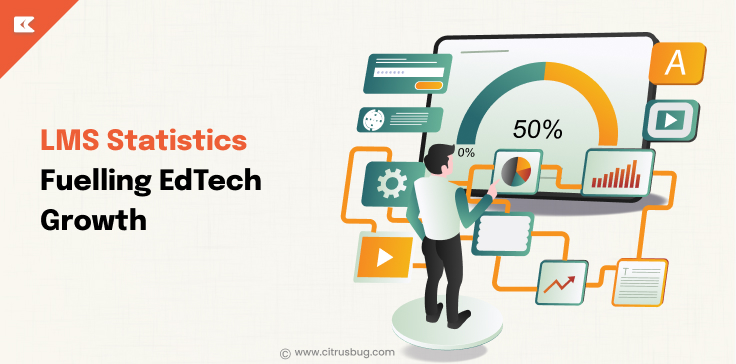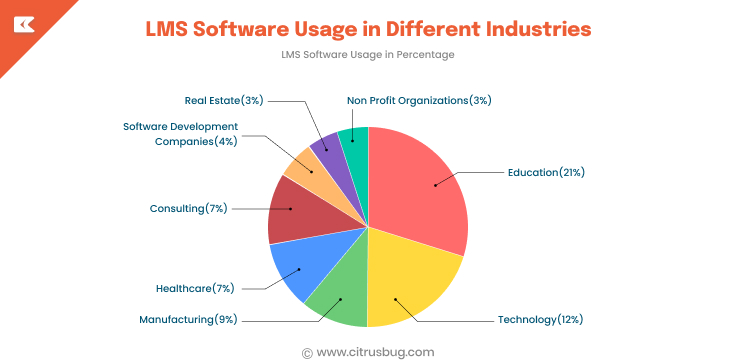Learning Management System (LMS) Statistics in 2025
- June 20, 2025
-
2190 Views
- by Ishan Vyas

The EdTech landscape continues to evolve rapidly, driven by digital transformation and innovative learning solutions. At the heart of this rapid evolution are Learning Management Systems, the foundational technology transforming the delivery and experience of education. By harnessing data-driven insights to optimize LMS statistics for better learning experiences while driving growth of a $400+ billion global EdTech market by 2025.
This blog delves deep into why Learning Management Systems matter for EdTech growth, unveils key LMS statistics driving its expansion, and shows their influence over emerging EdTech trends. No matter if you are an educator, an EdTech entrepreneur, or seeking more insight into Generative AI applications in education, this guide offers invaluable knowledge that will keep you ahead of the competition by 2025.
Why LMS Matters in EdTech
Learning Management Systems (LMSs) have emerged as the digital backbone of modern education, serving as the infrastructure required to deliver consistent, scalable, and accessible learning experiences to remote students, hybrid classrooms, and digital skill development initiatives. Institutions use LMS platforms as they work toward managing content delivery while tracking learner progress while encouraging collaboration across their institutions or businesses.
LMS platforms play a critical role in EdTech innovation by offering more than course delivery alone. By personalizing learning experiences and automating administrative tasks while integrating emerging technologies such as AI and gamification to increase engagement.
To achieve effective personalization, it’s crucial to design content around the different types of learning styles, such as visual, auditory, reading/writing, and kinesthetic so that learners can engage with material in a way that best suits their preferences.
As student expectations change and new learning models emerge, these systems will remain an integral component of digital education ecosystems until 2025 when demand for elearning software development and digital education surges globally.
Key LMS Statistics for 2025
Here we explore critical LMS statistics that showcase not only the systems’ growing influence in EdTech but also their potential to drive engagement, enhance learner outcomes, and support digital transformation.
LMS Market Size and Growth
- The Learning Management System (LMS) market is projected to expand from USD 18.9 Billion in 2024 to USD 44.5 billion by 2032, marking a 14.6% CAGR from 2024 to 2032. Additionally, the learning management systems market size was estimated at USD 16.4 billion in 2023. This illustrates the increasing necessity of e-learning programs in various industries.
- These developments are being driven by changing corporate and organizational priorities,including rapid technology adoption in business, skill development for the workforce, and the emergence of mobile-first LMS frameworks.
- Across multiple forecasts, the LMS market is poised for double-digit growth, with CAGR estimates between 16.7% and 19.9%, reaching USD 70–100 billion by the early 2030s.
This accelerated growth demonstrates how actively organizations are investing in developing elearning systems to prepare for a future with a more inclusive and impactful learning environment.
Regional Market Breakdown
An analysis of regional LMS adoption reveals a diverse picture of EdTech readiness and investment around the globe. Instead of solely looking at global forecasting models, this section illustrates where Learning Management Systems have taken hold in different parts of the globe, highlighting which regions lead in terms of growth dynamics, infrastructure investment and user engagement.
North America
- Holds the largest share, accounting for 38–43% of the global LMS market in 2024.
- The region is first in LMS adoption, with over 80% of major enterprises and education institutions leveraging LMS platforms.
Europe
- Europe is expected to dominate this region, holding between 25 to 30% of the global market share, shaped by strong eLearning adoption in Universities and Vocational training.
- Almost all higher-education institutions in Western Europe rely on LMS for blended or online learning.
Asia‑Pacific (APAC)
- Accounts for 20–25% of the LMS market and is the fastest-growing region.
- Estimated annual growth rate exceeds 20–23%, thanks to expanding digital education and mobile learning in countries like India and China.
[Source]
Latin America
- Makes up around 11% of global LMS share, with expectations to grow to USD 3.7 billion by 2030, at a 17.1% CAGR.
Middle East & Africa (MEA)
- Contributes about 10% of global LMS usage, with expected growth toward USD 3.1 billion by 2030, at a 22% CAGR .
Adoption and Usage Statistics
- Around 73% of US teachers state that technology-based learning platforms like LMS significantly improve student engagement.
- As of 2023, LMS platforms serve 73.8 million users, with 65 % being executives and 35 % managers.
- 87 % of LMS programs are web-based, and over 87 % of organizations operate cloud-based LMS systems.
- In higher education, 99 % of colleges use an LMS, with 77 % of faculty viewing it as vital for teaching.
These high adoption rates demonstrate that LMS development is no longer optional; it is critical for organizations prioritizing education at scale.
Corporate LMS Adoption Trends
In 2025, over 83% of businesses globally use LMS platforms to deliver employee training, as per Statista. Businesses are adopting Learning Management Systems (LMS) to cut training expenses, enhance information retention, and meet mandatory compliance standards.
The Corporate Learning Management System (LMS) market is projected to grow from about USD 11.3 billion in 2024 to USD 40 billion by 2031, marking a CAGR of roughly 16%.
Around 40% of Fortune 500 companies use LMS platforms for training, while overall LMS adoption is as high as 98% in large organizations and 96% in midsize companies.
Engagement and Learning Outcomes
LMS platforms are integral to boosting learning outcomes, with an observed increase in retention by up to 60%, versus 8–10 % for traditional methods, Additionally:
- AI-powered adaptive learning can boost student performance by up to 25% compared to traditional methods.
- Learners with access to gamified LMS modules show an average engagement increase of 60%.
- Online learning now accounts for 30% of training hours; this is projected to grow to 85 % by 2032.
- 90% of students prefer e-learning to traditional classrooms, and 75 % of employees prefer video-based learning.
- In North America, LMS adoption exceeds 95% of L&D departments by 2032.
- Microlearning can improve retention by up to 80%, and 94 % of L&D professionals favor microlearning.
- Cloud-based LMS is projected to grow with a 24.6% CAGR from 2021–2029, and 65 %+ of users access via mobile devices.
This underscores the importance of including advanced engagement features in LMS design.
Technology Adoption in LMS
LMS platforms continue evolving rapidly as organizations incorporate advanced technologies, driving increased personalization, efficiency, and competitive differentiation.
AI & ML Are Becoming Standard
As of 2024, roughly 47% of learning management systems (LMS) incorporate features such as adaptive learning, intelligent tutors, and feedback automation technologies. These systems now dynamically adjust to the distinct requirements of every learner, thus boosting engagement and retention rates.
The Global E-Learning VR Market is expected to be worth around USD 14,662.13 Million By 2034, up from USD 344.8 Million in 2024. It is expected to grow at a CAGR of 45.50% from 2025 to 2034.
Mobile-First Is No Longer Optional
In response to learner preferences, LMS vendors are adopting mobile-first strategies. Projections estimate that the mobile learning sector will be valued at USD 287 billion by 2030, marking a nearly 25% CAGR increase. This development represents the demand for constant access across devices as well as powerful seamless mobile usability.
AI in EdTech is Explosive
The education space driven by artificial intelligence has undergone tremendous growth in recent years. The sector will grow from USD 5.88 billion in 2024 to USD 32.3 billion by 2030, with a compound annual growth rate of over 31 percent. This indicates significant investment in advanced predictive analytics, complex intelligent tutoring systems, and new Learning Management Systems (LMS) with conversational capabilities.
Institutional Adoption Is Strong
A 2024 survey of U.S. and Canadian faculty showed that 93% plan to increase AI usage in their institutions in the next two years. In addition, educational research confirms the positive impact of integrated AI systems within LMS, such as adaptive assessments and analytics dashboards, on education quality and learner outcomes.
How LMS Statistics Drive EdTech Innovation
- Track Adoption Trends: LMS statistics offer a window into the use of learning technologies across various sectors and disciplines. The high adoption rates in education and corporate training signal a strong demand for scalable, dependable platforms.
- Respond to Learner Preferences: Statistics such as “90% of students prefer e-learning” help shift developer and strategist focus towards emerging behavioral dynamics and expectations of learners. At the same time, many learners are increasingly turning to online courses to gain new skills at their own pace.
- Guide Product Development: Design and feature priorities of educational technology products are shaped by trends such as 65% of users accessing LMS software on mobile devices, or increased interest in microlearning and video content.
- Support Strategic Decisions: These statistics assist stakeholders in making informed investment decisions, curriculum design, and funding while aligning proposals to market needs.
- Foster Innovation: Analytics assist in implementing advanced technologies such as AI, making educational platforms more adaptive and tailored to individual learners to foster improved learning outcomes.
Key Takeaways for EdTech Professionals
- Scalability Is Key: With market projections reaching USD 70-100 billion by early 2030s, LMS solutions that scale are essential to driving expansion and growth.
- Personalization Matters: Increased student and employee engagement rates on AI-powered and gamified platforms emphasize the necessity of adaptive learning strategies.
- Data-Driven Strategy: Analytics offer a structure for advancing not only product development and also improving the learner experience.
- Mobile-First Design: With mobile devices becoming so prevalent, LMS platforms will now be turning to design mobile-friendly responsive sites that are accessible and user-friendly on smartphones and other handheld devices.
- Microlearning and Multimedia: Short attention grabbing videos should direct the content strategy of the LMS for maximum engagement.
Future of LMS in EdTech
LMS’ future lies within education technology is exciting yet highly dependent on their adaptability. Innovation in LMS development may involve fully integrated platforms incorporating AI, AR/VR technologies and data-driven insights, for instance:
- Platforms utilizing Generative AI provide personalized recommendations, conversational tutors and even automatically generated learning content for their customers.
- Augmented and Virtual Reality (AR/VR) could add an exciting dimension to LMSs, helping employees and students alike master real world applications through virtual environments.
As technology becomes ever more integral to education, LMS systems will play a more prominent role in its digital transformation. This trend is also fueling innovation in education app development, where institutions and businesses create tailored learning solutions that extend beyond standard LMS capabilities.
Summing Up
As Learning Management Systems continue their rapid rise, their impact can no longer be ignored. Data clearly demonstrates:
- Demand is rising for flexible, scalable and technology-driven learning solutions that provide maximum flexibility and efficiency.
- Increasing adoption of mobile, AI-powered, and microlearning features to meet modern learner expectations.
- Attractively investing and innovating by following usage statistics and user behaviors.
EdTech professionals understand the significance of LMS data to their profession; staying ahead with LMS statistics isn’t simply useful, it’s essential. With digital education’s continued expansion, those using insights gleaned from LMS analysis to inform product design decisions, content strategies, LMS development, and platform architecture will drive impactful learning solutions into existence.





 SaaS Development
SaaS Development Web Application Development
Web Application Development Mobile Application Development
Mobile Application Development Custom Software Development
Custom Software Development Cloud Development
Cloud Development DevOps Development
DevOps Development MVP Development
MVP Development Digital Product Development
Digital Product Development Hire Chatbot Developers
Hire Chatbot Developers Hire Python Developers
Hire Python Developers Hire Django Developers
Hire Django Developers Hire ReactJS Developers
Hire ReactJS Developers Hire AngularJS Developers
Hire AngularJS Developers Hire VueJS Developers
Hire VueJS Developers Hire Full Stack Developers
Hire Full Stack Developers Hire Back End Developers
Hire Back End Developers Hire Front End Developers
Hire Front End Developers AI Healthcare Software Development & Consulting
AI Healthcare Software Development & Consulting Healthcare App Development
Healthcare App Development EHR Software Development
EHR Software Development Healthcare AI Chatbot Development
Healthcare AI Chatbot Development Telemedicine App Development Company
Telemedicine App Development Company Medical Billing Software Development
Medical Billing Software Development Fitness App Development
Fitness App Development RPM Software Development
RPM Software Development Medicine Delivery App Development
Medicine Delivery App Development Medical Device Software Development
Medical Device Software Development Patient Engagement Software Solutions
Patient Engagement Software Solutions Mental Health App Development
Mental Health App Development Healthcare IT Consulting
Healthcare IT Consulting Healthcare CRM Software Development
Healthcare CRM Software Development Healthcare IT Managed Services
Healthcare IT Managed Services Healthcare Software Testing services
Healthcare Software Testing services Medical Practice Management Software
Medical Practice Management Software Outsourcing Healthcare IT Services
Outsourcing Healthcare IT Services IoT Solutions for Healthcare
IoT Solutions for Healthcare Medical Image Analysis Software Development Services
Medical Image Analysis Software Development Services Lending Software Development Services
Lending Software Development Services Payment Gateway Software Development
Payment Gateway Software Development Accounting Software Development
Accounting Software Development AI-Driven Banking App Development
AI-Driven Banking App Development Insurance Software Development
Insurance Software Development Finance Software Development
Finance Software Development Loan Management Software Development
Loan Management Software Development Decentralized Finance Development Services
Decentralized Finance Development Services eWallet App Development
eWallet App Development Payment App Development
Payment App Development Money Transfer App Development
Money Transfer App Development Mortgage Software Development
Mortgage Software Development Insurance Fraud Detection Software Development
Insurance Fraud Detection Software Development Wealth Management Software Development
Wealth Management Software Development Cryptocurrency Exchange Platform Development
Cryptocurrency Exchange Platform Development Neobank App Development
Neobank App Development Stock Trading App Development
Stock Trading App Development AML software Development
AML software Development Web3 Wallet Development
Web3 Wallet Development Robo-Advisor App Development
Robo-Advisor App Development Supply Chain Management Software Development
Supply Chain Management Software Development Fleet Management Software Development
Fleet Management Software Development Warehouse Management Software Development
Warehouse Management Software Development LMS Development
LMS Development Education App Development
Education App Development Inventory Management Software Development
Inventory Management Software Development Property Management Software Development
Property Management Software Development Real Estate CRM Software Development
Real Estate CRM Software Development Real Estate Document Management Software
Real Estate Document Management Software Construction App Development
Construction App Development Construction ERP Software Development
Construction ERP Software Development











